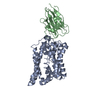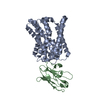[English] 日本語
 Yorodumi
Yorodumi- PDB-7pqg: Structure of thermostabilised human NTCP in complex with nanobody 87 -
+ Open data
Open data
- Basic information
Basic information
| Entry | Database: PDB / ID: 7pqg | ||||||
|---|---|---|---|---|---|---|---|
| Title | Structure of thermostabilised human NTCP in complex with nanobody 87 | ||||||
 Components Components |
| ||||||
 Keywords Keywords | MEMBRANE PROTEIN / SLC10A1 / sodium bile acid symporter | ||||||
| Function / homology |  Function and homology information Function and homology informationbile acid:sodium symporter activity / regulation of bile acid secretion / bile acid and bile salt transport / bile acid signaling pathway / Recycling of bile acids and salts / response to nutrient levels / response to organic cyclic compound / response to estrogen / cellular response to xenobiotic stimulus / virus receptor activity ...bile acid:sodium symporter activity / regulation of bile acid secretion / bile acid and bile salt transport / bile acid signaling pathway / Recycling of bile acids and salts / response to nutrient levels / response to organic cyclic compound / response to estrogen / cellular response to xenobiotic stimulus / virus receptor activity / basolateral plasma membrane / response to ethanol / plasma membrane Similarity search - Function | ||||||
| Biological species |   Homo sapiens (human) Homo sapiens (human) | ||||||
| Method | ELECTRON MICROSCOPY / single particle reconstruction / cryo EM / Resolution: 3.7 Å | ||||||
 Authors Authors | Goutam, K. / Reyes, N. | ||||||
| Funding support | European Union, 1items
| ||||||
 Citation Citation |  Journal: Nature / Year: 2022 Journal: Nature / Year: 2022Title: Structural basis of sodium-dependent bile salt uptake into the liver. Authors: Kapil Goutam / Francesco S Ielasi / Els Pardon / Jan Steyaert / Nicolas Reyes /   Abstract: The liver takes up bile salts from blood to generate bile, enabling absorption of lipophilic nutrients and excretion of metabolites and drugs. Human Na-taurocholate co-transporting polypeptide (NTCP) ...The liver takes up bile salts from blood to generate bile, enabling absorption of lipophilic nutrients and excretion of metabolites and drugs. Human Na-taurocholate co-transporting polypeptide (NTCP) is the main bile salt uptake system in liver. NTCP is also the cellular entry receptor of human hepatitis B and D viruses (HBV/HDV), and has emerged as an important target for antiviral drugs. However, the molecular mechanisms underlying NTCP transport and viral receptor functions remain incompletely understood. Here we present cryo-electron microscopy structures of human NTCP in complexes with nanobodies, revealing key conformations of its transport cycle. NTCP undergoes a conformational transition opening a wide transmembrane pore that serves as the transport pathway for bile salts, and exposes key determinant residues for HBV/HDV binding to the outside of the cell. A nanobody that stabilizes pore closure and inward-facing states impairs recognition of the HBV/HDV receptor-binding domain preS1, demonstrating binding selectivity of the viruses for open-to-outside over inward-facing conformations of the NTCP transport cycle. These results provide molecular insights into NTCP 'gated-pore' transport and HBV/HDV receptor recognition mechanisms, and are expected to help with development of liver disease therapies targeting NTCP. | ||||||
| History |
|
- Structure visualization
Structure visualization
| Structure viewer | Molecule:  Molmil Molmil Jmol/JSmol Jmol/JSmol |
|---|
- Downloads & links
Downloads & links
- Download
Download
| PDBx/mmCIF format |  7pqg.cif.gz 7pqg.cif.gz | 82.3 KB | Display |  PDBx/mmCIF format PDBx/mmCIF format |
|---|---|---|---|---|
| PDB format |  pdb7pqg.ent.gz pdb7pqg.ent.gz | 62.3 KB | Display |  PDB format PDB format |
| PDBx/mmJSON format |  7pqg.json.gz 7pqg.json.gz | Tree view |  PDBx/mmJSON format PDBx/mmJSON format | |
| Others |  Other downloads Other downloads |
-Validation report
| Summary document |  7pqg_validation.pdf.gz 7pqg_validation.pdf.gz | 639.1 KB | Display |  wwPDB validaton report wwPDB validaton report |
|---|---|---|---|---|
| Full document |  7pqg_full_validation.pdf.gz 7pqg_full_validation.pdf.gz | 653.4 KB | Display | |
| Data in XML |  7pqg_validation.xml.gz 7pqg_validation.xml.gz | 19.1 KB | Display | |
| Data in CIF |  7pqg_validation.cif.gz 7pqg_validation.cif.gz | 25.9 KB | Display | |
| Arichive directory |  https://data.pdbj.org/pub/pdb/validation_reports/pq/7pqg https://data.pdbj.org/pub/pdb/validation_reports/pq/7pqg ftp://data.pdbj.org/pub/pdb/validation_reports/pq/7pqg ftp://data.pdbj.org/pub/pdb/validation_reports/pq/7pqg | HTTPS FTP |
-Related structure data
| Related structure data |  13593MC  7pqqC M: map data used to model this data C: citing same article ( |
|---|---|
| Similar structure data | Similarity search - Function & homology  F&H Search F&H Search |
- Links
Links
- Assembly
Assembly
| Deposited unit | 
|
|---|---|
| 1 |
|
- Components
Components
| #1: Antibody | Mass: 14988.481 Da / Num. of mol.: 1 Source method: isolated from a genetically manipulated source Source: (gene. exp.)   |
|---|---|
| #2: Protein | Mass: 36652.391 Da / Num. of mol.: 1 Source method: isolated from a genetically manipulated source Source: (gene. exp.)  Homo sapiens (human) / Gene: SLC10A1, NTCP, GIG29 / Cell line (production host): HEK293F / Production host: Homo sapiens (human) / Gene: SLC10A1, NTCP, GIG29 / Cell line (production host): HEK293F / Production host:  Homo sapiens (human) / References: UniProt: Q14973 Homo sapiens (human) / References: UniProt: Q14973 |
-Experimental details
-Experiment
| Experiment | Method: ELECTRON MICROSCOPY |
|---|---|
| EM experiment | Aggregation state: PARTICLE / 3D reconstruction method: single particle reconstruction |
- Sample preparation
Sample preparation
| Component | Name: Human NTCP in complex with nanobody 87 / Type: COMPLEX / Entity ID: all / Source: MULTIPLE SOURCES | ||||||||||||
|---|---|---|---|---|---|---|---|---|---|---|---|---|---|
| Source (natural) |
| ||||||||||||
| Source (recombinant) |
| ||||||||||||
| Buffer solution | pH: 7.4 | ||||||||||||
| Specimen | Embedding applied: NO / Shadowing applied: NO / Staining applied: NO / Vitrification applied: YES | ||||||||||||
| Vitrification | Cryogen name: ETHANE |
- Electron microscopy imaging
Electron microscopy imaging
| Experimental equipment |  Model: Titan Krios / Image courtesy: FEI Company |
|---|---|
| Microscopy | Model: FEI TITAN KRIOS |
| Electron gun | Electron source:  FIELD EMISSION GUN / Accelerating voltage: 300 kV / Illumination mode: FLOOD BEAM FIELD EMISSION GUN / Accelerating voltage: 300 kV / Illumination mode: FLOOD BEAM |
| Electron lens | Mode: BRIGHT FIELD |
| Image recording | Electron dose: 57.8 e/Å2 / Film or detector model: GATAN K3 BIOQUANTUM (6k x 4k) |
- Processing
Processing
| Software |
| ||||||||||||||||||||||||
|---|---|---|---|---|---|---|---|---|---|---|---|---|---|---|---|---|---|---|---|---|---|---|---|---|---|
| CTF correction | Type: PHASE FLIPPING AND AMPLITUDE CORRECTION | ||||||||||||||||||||||||
| 3D reconstruction | Resolution: 3.7 Å / Resolution method: FSC 0.143 CUT-OFF / Num. of particles: 61053 / Symmetry type: POINT | ||||||||||||||||||||||||
| Refinement | Cross valid method: NONE Stereochemistry target values: GeoStd + Monomer Library + CDL v1.2 | ||||||||||||||||||||||||
| Displacement parameters | Biso mean: 156.22 Å2 | ||||||||||||||||||||||||
| Refine LS restraints |
|
 Movie
Movie Controller
Controller



 PDBj
PDBj




